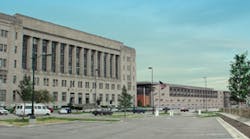Millions of Americans dread Tax Day, but for a construction team in Kansas City, Mo., April 15, 2005, will mark an important milestone in a $381 million, three-year project. On this date, the crew will take possession of the 75-year-old Main Post Office building, which will be transformed into the new home of the Internal Revenue Service (IRS).
The IRS is consolidating seven of its Kansas City-area facilities into one 1.14 million-square-foot campus, which will serve as one of only two IRS paper processing facilities in the country. About 1,000 construction workers will renovate the historic 476,000-square-foot post office building and construct three new processing centers, a warehouse, and a 3,800-car underground parking garage. In conjunction with the project, the crew will also prepare space for the U.S. Post Office directly across the street from the jobsite at Union Station, a renovated train station, as well as in the adjacent freight-handling facility.
Kansas City, Mo.-based Mark One Electric, the prime electrical subcontractor on the project, partnered with Kansas City, Mo.-based Capital Electric to provide power and lighting to the new IRS campus. The electrical contracting firms arrived on the site last year to relocate all of the existing underground electrical and communication utilities and construct a new 2MW primary power feed. The electricians also installed a 480V transformer at the base of each of the six tower cranes to feed temporary power to 69 different locations throughout the construction site. To maximize efficiency and productivity during daylight savings time, the electrical team installed a 1,500W metal-halide light on each of the four sections of the tower crane, which provided 3 footcandles of illumination and allowed the general contractor to gain one extra hour per day of production during the winter months.
The general contractor, J.E. Dunn Construction, was also able to increase efficiency during the early stages of the project through a design/build relationship with Mark One, says Bill Edwards, assistant vice president of J.E. Dunn. In particular, this business relationship allowed the electrical team to start electrical construction in the parking garage well before the buildings were designed. “We were able to cut six months off the schedule by having them involved early in the planning process,” Edwards says.
The electricians are currently roughing in circuitry for the lighting system in the underground parking garage and preparing to tackle the power distribution system on the site.
While the new construction involves creation of traditional Class A office space, the renovation of the post office building will present a special set of challenges. Carl Privitera, vice president of engineering for Mark One Electric, says adapting the post office building for its new use will require an extensive amount of electrical demolition. “The five existing substations will have to be decommissioned, removed, and kept in operation for temporary power,” he says.
The electrical team needs to not only follow historical preservation guidelines when renovating the post office, but also adhere to requirements of the Leadership in Energy and Environmental Design (LEED) program. One of LEED's principal objectives is to reduce the amount of light pollution, so the electricians will install cutoff style fixtures with zero illumination at the property lines to prevent light from spilling onto adjacent property. The use of daylighting in the building will also reduce energy costs.
The construction team plans to turn over the new processing centers to the IRS in October 2006 and the renovated post office building in December 2006. If you file a paper tax return in the next few years, there's a good chance it will be processed in the heart of downtown Kansas City.
Sidebar: Jobsite Facts and Figures
- Electricians will install 1,600 light fixtures in the 1-million-square-foot underground parking garage.
- Each processing center will feature 12 electrical rooms.
- A medium-voltage, two-circuit 13,600V primary circuit will feed the entire campus, and a 5,000A, 480/277V service will serve each wing.



